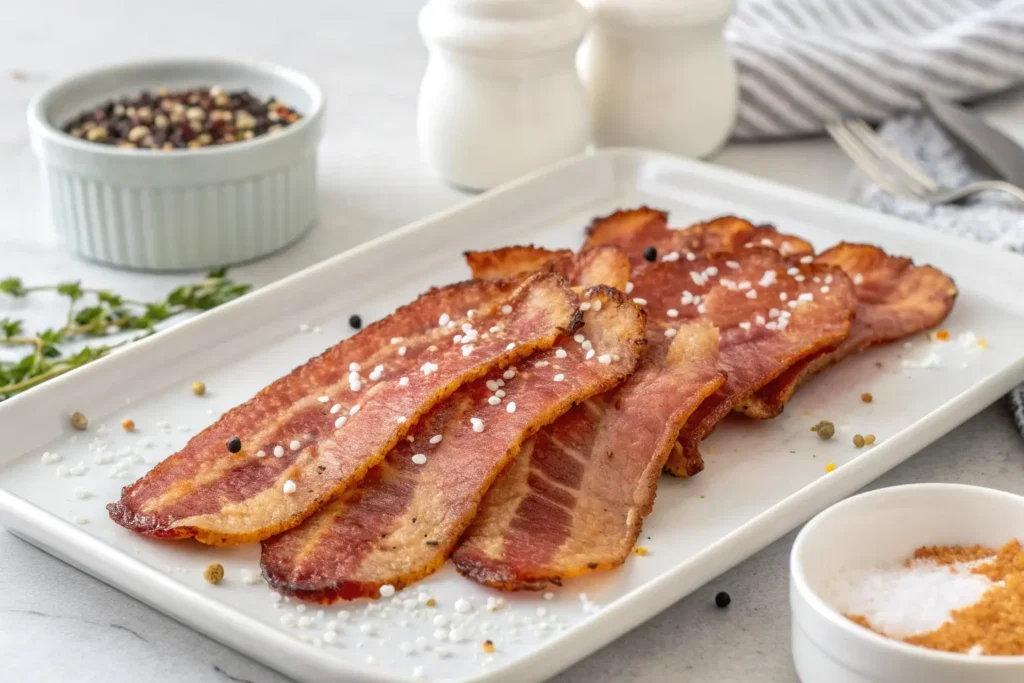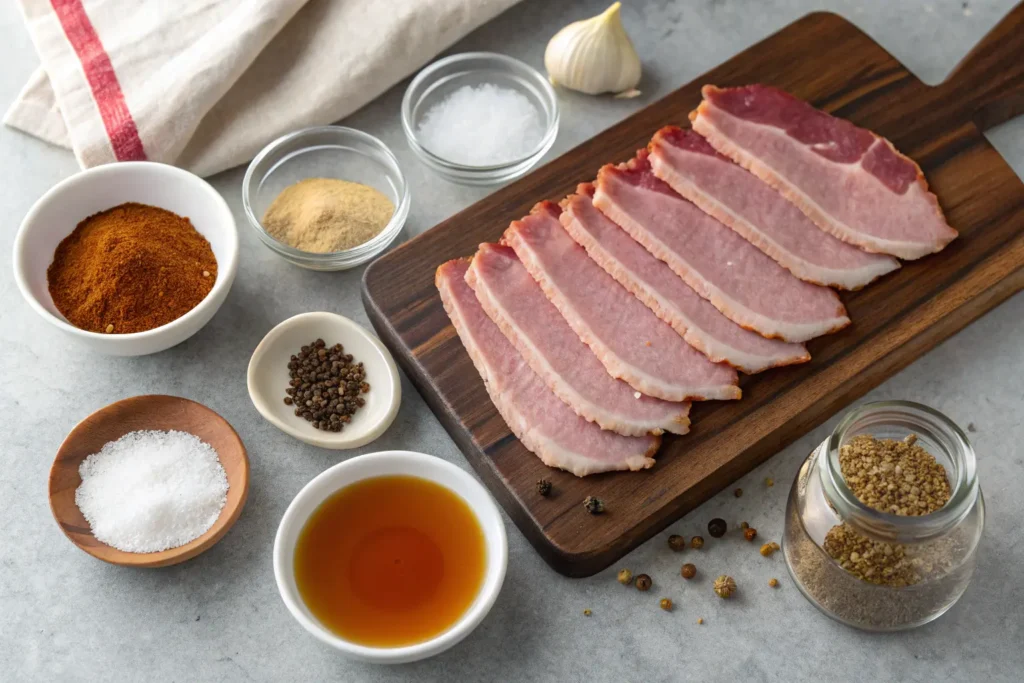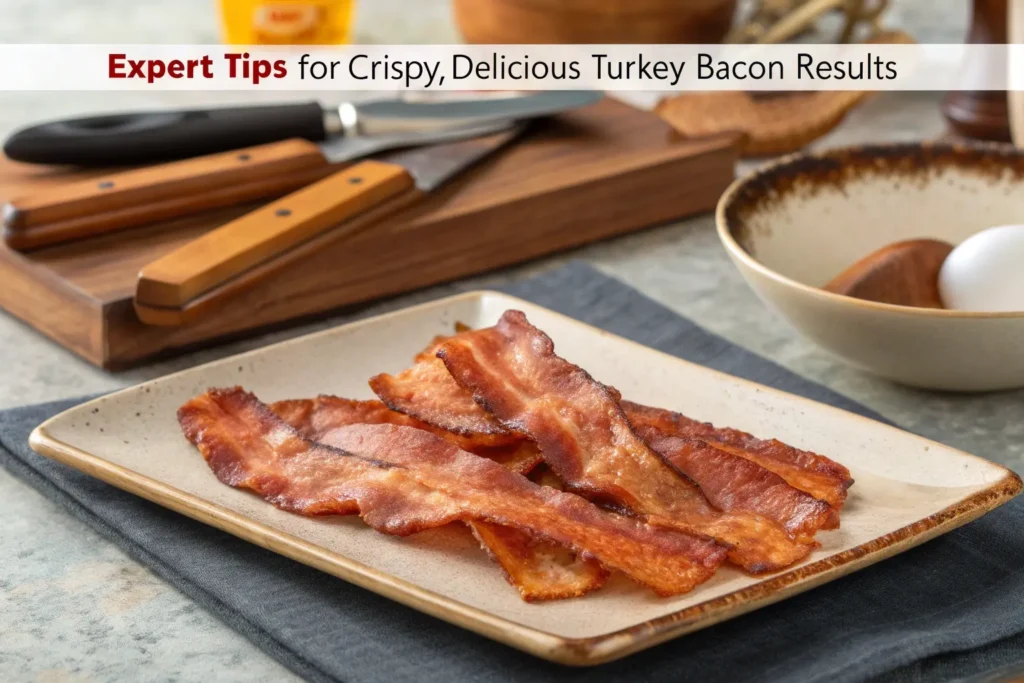The sizzle hit my ears before the aroma wafted across the kitchen. Another Sunday morning, another disappointing attempt at making turkey bacon actually taste good. The flimsy, pale strips bore little resemblance to the crispy, savory bacon experience I craved. After switching to turkey bacon for health reasons, breakfast had become a sad compromise – until everything changed.
Through sheer stubbornness and countless experiments, I discovered the techniques that transformed those limp strips into crispy, golden morsels that even my bacon-purist husband couldn’t resist stealing from my plate. That first perfect batch revealed what countless failed attempts had hidden: turkey bacon isn’t just a compromise; when prepared correctly, it’s a delicious protein worthy of celebration in its own right.
Table of contents

Why Turkey Bacon Deserves a Place in Your Kitchen
Turkey bacon has steadily climbed in popularity, with sales increasing by nearly 18% over the past five years according to market research firm Nielsen. This growth isn’t merely about health considerations – though cutting approximately 25% of calories and 35% of fat compared to traditional bacon certainly contributes to its appeal.
The real secret lies in understanding that turkey bacon requires different cooking approaches than its pork counterpart. When you master these techniques, you’ll discover a versatile ingredient that shines in everything from breakfast classics to sophisticated dinner applications. Plus, many households find turkey bacon offers a more wallet-friendly option for incorporating bacon flavor into weekly meal plans.
Understanding What Turkey Bacon Really Is
Before mastering any ingredient, understanding its composition proves essential. Unlike traditional bacon, which comes from pork belly, turkey bacon combines light and dark turkey meat, seasoned and pressed into strips resembling conventional bacon. Manufacturers typically add seasonings, smoke flavoring, and preservatives to mimic traditional bacon’s taste profile.
Most products undergo curing with salt and sodium nitrite or nitrate (though nitrate-free varieties exist). This processing creates turkey bacon’s distinctive appearance, with alternating light and dark sections designed to visually resemble the fat and meat layers in pork bacon.
Varieties span from conventional options at most supermarkets to specialty products including uncured, organic, and lower-sodium alternatives found at health food retailers and premium grocers.
Nutritional Benefits of Choosing Turkey Bacon
Many people initially reach for turkey bacon seeking healthier breakfast options. Understanding the actual nutritional differences helps establish reasonable expectations.
Turkey Bacon Nutrition Facts
| Nutrient | Turkey Bacon (2 slices) | Pork Bacon (2 slices) | Difference |
|---|---|---|---|
| Calories | 60-70 | 80-90 | ~25% fewer |
| Total Fat | 4.5g | 7g | ~35% less |
| Saturated Fat | 1.5g | 2.5g | ~40% less |
| Cholesterol | 30mg | 20mg | 50% more |
| Protein | 6g | 6g | Same |
| Sodium | 480mg | 380mg | 26% more |
Health Considerations When Selecting Turkey Bacon
While turkey bacon delivers advantages in total fat and calorie content, it’s crucial to recognize it’s still a processed meat product. The higher sodium content particularly warrants attention if you’re monitoring salt intake for health reasons. Several brands now offer reduced-sodium varieties that address this concern.
For maximum health benefits, consider brands that avoid artificial nitrates and nitrites, instead using natural preservatives like celery powder. While these alternatives still contain naturally occurring nitrates, some research suggests they may pose fewer health concerns than synthetic versions.
Remember that turkey bacon works well within numerous dietary approaches including Mediterranean and DASH eating plans when consumed in moderation. Consider it an occasional protein option rather than a daily staple if optimal nutrition remains your priority.
Shopping Guide: Selecting the Best Turkey Bacon
Brand selection significantly impacts your turkey bacon experience. After extensive sampling (somebody had to do the difficult research!), clear differences emerged in texture, flavor, and cooking performance.
Top Turkey Bacon Brands Worth Trying
| Brand | Key Features | Best Used For | Approximate Price |
|---|---|---|---|
| Applegate Naturals | Uncured, no antibiotics | Direct consumption | $5.99/8oz |
| Butterball | Widely available, consistent | Recipes, wrapping | $3.99/12oz |
| Jennie-O | Extra thin option available | Crispy applications | $4.49/12oz |
| Oscar Mayer | Budget-friendly | Everyday cooking | $3.29/12oz |
| Trader Joe’s | No nitrates/nitrites | Health-conscious | $3.99/8oz |
What to Look for on Turkey Bacon Labels
When browsing options, flip packages over to examine ingredient lists rather than just front-label claims. Watch for sodium levels, which vary dramatically between brands. Some products contain surprising ingredients like corn syrup or maple flavoring that affect taste and nutrition.
Those concerned about additives should seek packages labeled “uncured” and “no nitrates or nitrites added,” though remember these products typically use natural nitrate sources like celery powder instead. For texture seekers, look at slice thickness – thinner slices generally crisp more easily, while thicker options maintain more substantial chew.
Essential Equipment for Perfect Turkey Bacon
Proper tools transform your turkey bacon results from mediocre to magnificent. Unlike pork bacon, which releases abundant fat during cooking, turkey bacon benefits from specific equipment considerations.
Must-Have Tools for Turkey Bacon Mastery
- Heavy-bottomed skillet (cast iron preferred) distributes heat evenly for consistent browning
- Rimmed baking sheets capture any rendering during oven preparation
- Wire cooling racks elevate bacon during baking, allowing hot air circulation for optimal crispiness
- High-quality tongs gently handle delicate strips without tearing
- Grease splatter screen contains mess during stovetop cooking
- Paper towels or dedicated bacon towels absorb excess grease after cooking
- Meat thermometer ensures food safety with precise temperature readings
Cast iron deserves special mention as the ultimate turkey bacon cooking surface. Its excellent heat retention and distribution create the perfect environment for developing crispiness without burning. If you’ve struggled with uneven cooking results, your lightweight aluminum pan might be the culprit.

Master Methods: How to Cook Turkey Bacon to Crispy Perfection
The single greatest revelation in my turkey bacon journey? Different cooking methods yield dramatically different results. Master these techniques to transform your breakfast experience.
The Skillet Method: Achieving Stovetop Crispiness
Begin with a crucial step many cooks skip: preheat your pan thoroughly over medium heat. Unlike pork bacon, turkey bacon benefits from a small amount of cooking oil – about two teaspoons of neutral oil like canola or avocado creates the ideal cooking environment.
Arrange strips without overlapping and resist the urge to constantly fiddle with them. Allow 4-5 minutes before the first flip, watching for golden brown edges as your signal. After flipping, another 3-4 minutes typically achieves ideal crispness.
Judge doneness by color and texture – properly cooked turkey bacon displays rich golden-brown color with distinctly dry (not glossy) surfaces. Thicker slices require slightly longer cooking times, so adjust accordingly if using premium thick-cut varieties.
Oven-Baked Turkey Bacon: The Consistent Approach
For feeding crowds or meal prepping, oven preparation delivers reliable results with minimal attention. Preheat your oven to 400°F – this temperature balances efficient cooking with control against burning.
Line a rimmed baking sheet with foil for easy cleanup, then position a wire rack above. Arrange bacon in a single layer on the rack, which allows heat circulation for optimal crisping. Bake for 15-20 minutes total, rotating the pan halfway through.
The wire rack technique eliminates the need to flip the bacon while ensuring crispiness on both sides – a game-changing discovery for busy breakfast preparation. For extra-crispy results, brush strips lightly with maple syrup or honey before baking.
Air Fryer Revolution: Quick and Crispy Turkey Bacon
For lightning-fast results with minimal cleanup, your air fryer offers unmatched convenience. Preheat to 360°F, then arrange strips in a single layer – likely requiring batch cooking depending on your air fryer capacity.
Cook for 5 minutes before checking doneness, then continue in 1-minute increments until reaching desired crispness. The forceful hot air circulation creates exceptionally crispy results without additional oil, making this perhaps the healthiest preparation method.
The primary limitation? Quantity constraints based on your appliance size. Consider this method ideal for preparing 2-4 servings quickly rather than larger batch cooking.
Common Turkey Bacon Cooking Mistakes to Avoid
Wondering why your turkey bacon never matches restaurant quality? These common errors might explain the disappointing results you’ve experienced.
Why Your Turkey Bacon Isn’t Crispy
- Starting with a cold pan forces bacon to steam rather than sear
- Overcrowding the cooking surface prevents proper browning
- Insufficient cooking time – turkey bacon requires longer than you might expect
- Improper heat management – too hot burns edges before centers crisp
- Skipping the preheating step (particularly important for oven methods)
- Not patting moisture from bacon before cooking, which inhibits browning
- Using no cooking fat, preventing proper heat transfer
The most dramatic improvement comes from patience – allowing proper cooking time without rushing. Turkey bacon transforms dramatically during the final minutes of cooking, so resist removing it prematurely when it merely looks “done enough.”
Beyond Breakfast: Creative Ways to Use Turkey Bacon
While morning meals might first come to mind, turkey bacon’s versatility extends far beyond the breakfast table. Its lower fat content actually makes it ideal for certain culinary applications where traditional bacon might overwhelm.
Turkey Bacon Recipe Inspirations
| Meal Category | Recipe Ideas | Key Turkey Bacon Role |
|---|---|---|
| Appetizers | Wrapped dates, Jalapeño poppers | Savory wrapper |
| Salads | Cobb, Spinach & warm bacon | Flavor accent, protein |
| Sandwiches | Turkey bacon BLT, Club sandwich | Main protein |
| Main Dishes | Carbonara, Quiche Lorraine | Flavor foundation |
| Sides | Baked beans, Brussels sprouts | Savory enhancement |
| Snacks | Turkey bacon crackers | Protein boost |
For appetizers, turkey bacon’s flexibility while partially cooked makes it ideal for wrapping dates or vegetables before baking. The lower fat content prevents excessive grease when used as a wrap compared to traditional bacon.
In pasta dishes like carbonara, pre-crisp and crumble turkey bacon, then supplement with a small amount of olive oil to compensate for the reduced fat renderings. This technique delivers bacon flavor while maintaining better nutritional profile than the traditional preparation.
Food Safety and Storage: Maximizing Turkey Bacon Freshness
Proper handling ensures both safety and quality in your turkey bacon experience. As a poultry product, turkey bacon requires more careful food safety attention than pork varieties.
Proper Handling of Raw Turkey Bacon
Always store raw turkey bacon at or below 40°F, and use within the package date guidelines or within seven days of opening, whichever comes first. Cross-contamination prevention requires thorough hand washing after handling raw product and sanitizing any surfaces touched during preparation.
Signs of spoilage include color changes (grayish or greenish tints), sour smell, or slimy texture. When in doubt, follow the food safety mantra: “When in doubt, throw it out.”
Storing Cooked Turkey Bacon
Properly cooked turkey bacon stores remarkably well, making it ideal for meal preparation. Refrigerate cooled strips in airtight containers, separated by parchment paper for easy removal. Consume within three days for optimal quality.
For longer storage, freezing works surprisingly well. Place completely cooled strips between parchment paper layers and store in freezer bags with air removed. Frozen cooked turkey bacon maintains quality for up to one month and reheats well in a warm skillet or microwave.
Embracing Turkey Bacon as a Versatile Kitchen Staple
The journey from disappointed compromise to enthusiastic turkey bacon advocate might sound familiar to many health-conscious cooks. The revelation comes when you stop treating turkey bacon as an inferior substitute and start approaching it as a unique ingredient with its own preparation requirements.
With proper cooking techniques, this versatile protein transforms from pale disappointment to golden, crispy satisfaction. Consider it not as “fake bacon” but as its own category of breakfast meat – one that offers creative cooking opportunities while aligning with modern nutritional awareness.
Ready to transform your own turkey bacon experience? Start with a quality brand, apply the cooking methods outlined here, and discover the satisfaction of perfectly prepared turkey bacon. Then share your creations – nothing convinces skeptics faster than surprising them with crispy, golden strips that challenge their preconceptions about this misunderstood breakfast option.

Frequently Asked Questions About Turkey Bacon
Q: Is turkey bacon actually healthier than regular bacon? A: Turkey bacon generally contains about 25% fewer calories and 35% less fat than pork bacon, making it a somewhat better option for those monitoring fat intake. However, turkey bacon often contains similar or higher amounts of sodium and may include similar preservatives, so “healthier” depends on your specific dietary concerns.
Q: Why won’t my turkey bacon get crispy like regular bacon? A: Turkey bacon has less fat than pork bacon, which affects crispiness. For crispier turkey bacon, try cooking it longer at moderate heat, use a wire rack when baking, ensure your pan is properly preheated, and consider adding a small amount of oil to the cooking surface.
Q: Can I cook turkey bacon in the microwave? A: Yes, turkey bacon can be cooked in the microwave. Place it in a single layer between paper towels on a microwave-safe plate and cook for about 2 minutes for 4 slices (time varies by microwave power). Check frequently as it can quickly go from perfect to overcooked.
Q: How do I know when turkey bacon is fully cooked? A: Properly cooked turkey bacon should be browned, appear dry rather than glossy, and reach an internal temperature of 165°F. It should have a firm texture and show some curling at the edges. Unlike pork bacon, turkey bacon won’t become quite as rigid when fully cooked.
Q: Can I freeze turkey bacon? A: Both raw and cooked turkey bacon freeze well. For raw turkey bacon, you can freeze it in its original packaging for up to 2 months. For cooked turkey bacon, cool completely, wrap slices between parchment paper, and store in a freezer bag for up to 1 month. Reheat frozen cooked turkey bacon in a skillet, oven, or microwave.
Q: Why does my turkey bacon curl up when cooking? A: Turkey bacon curls during cooking due to uneven heat causing protein contraction and moisture loss. To minimize curling, use a bacon press or wire rack, cook at moderate rather than high heat, and start with a room-temperature product rather than cooking directly from the refrigerator.
Q: Can I eat turkey bacon raw? A: No, turkey bacon should never be consumed raw. Like other poultry products, raw turkey bacon may contain harmful bacteria. Always cook turkey bacon until it reaches an internal temperature of 165°F to ensure food safety.
Have you given our recipe a try?
There are no reviews yet. Be the first one to write one.

